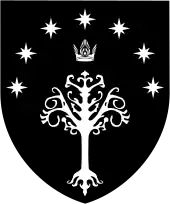The Dry Tree (or Tree Solitary) is a legendary tree. It was recorded first by Marco Polo, somewhere in northern Persia. According to Polo, it was the only tree within hundreds of kilometres of desert. According to legend, the Dry Tree marked the exact site of a great battle between Alexander the Great and Darius. It is not known whether this "great battle" refers to the Battle of Issus or the Battle of Gaugamela. The purported location—somewhere in Khorasan, near the border with present day Turkmenistan—is also impossible to ascertain, because Darius had already been assassinated when Alexander reached these regions.
Overview
Marco Polo describes the Dry Tree as a large tree with green leaves on one side and white leaves on the other. For that reason, the Dry tree may have been a plane tree.[1]
The Dry Tree is described by the 14th century Travels of Sir John Mandeville.[2] The tale runs that the Dry Tree has been lifeless since the crucifixion of Christ, but that it will flower afresh when "a prince of the west side of the world should sing a mass beneath it".[3]
Legends of Alexander the Great tell that he found the phoenix, a bird able to bring itself back to life, in the branches of the Dry Tree.[4]
A solitary dry tree is visible on the Issus-mosaic from Pompeii, showing where Alexander met Darius the Great of Persia.[1]
The Dry Tree was reported by the Bavarian adventurer Johannes Schiltberger (1380..c1440), who compared it to the Oak of Mamre. He said that Muslims called this tree "Kurrutherek" or "Sirpe". This last word is close to the Turco-Persian word meaning "cyperus". The Spanish ambassador Ruy Gonzáles de Clavijo said that the tree was in Tabriz.[5]
Real-world parallels
Although the story is a legend, solitary trees do exist. The Tree of Ténéré was such an isolated tree in the West-African state of Niger, serving as a landmark; the nearest tree to it was said to be 400 km away (it was knocked down in 1973 by a truck driver).[1]
Legacy
In J. R. R. Tolkien's The Lord of the Rings, the symbol of the Kingdom of Gondor is a White Tree. It stands in the Court of the Fountain at the top of the city, dry and lifeless throughout the centuries that Gondor was ruled by the Stewards. It has been likened to the Dry Tree, since a sapling of the White Tree is found and brought into the city by the returning King, Aragorn.[3]
See also
References
- 1 2 3 "Alexander the Great's web site". Archived from the original on February 16, 2007.
- ↑ Gasse, Rosanne (2013). "The Dry Tree Legend in Medieval Literature". In Gusick, Barbara I. (ed.). Fifteenth-Century Studies 38. Camden House. pp. 65–96. ISBN 978-1-57113-558-2.
Mandeville also includes a prophecy that when the Prince of the West conquers the Holy Land for Christianity, this dead tree will become green again, rather akin to the White Tree of Arnor [sic] in the Peter Jackson film version of The Lord of the Rings, if not in Tolkien's original novel, which sprouts new green leaves when Aragorn first arrives in Gondor at [sic, i.e. after] the Battle of the Pelennor Fields.
- 1 2 3 Garth, John (2020). The Worlds of J.R.R. Tolkien: The Places that Inspired Middle-earth. Frances Lincoln Publishers & Princeton University Press. p. 41. ISBN 978-0-7112-4127-5.
- ↑ Drieshen, Clark (31 January 2020). "The Trees of the Sun and the Moon". British Library. Retrieved 24 February 2021.
- ↑ "Voyage of Marco Polo, Book 2, ch. 17. Of the Town of Taurisium". L'Encyclopedie de l'Agora. Archived from the original on 10 October 2007. Retrieved 24 February 2021.
- This page began as a translation of its French equivalent.
